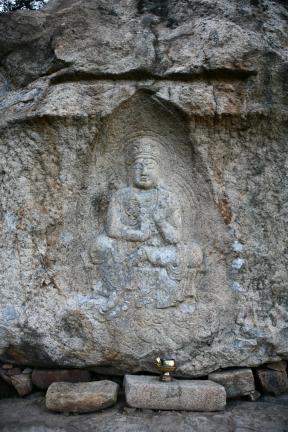경주 남산 신선암 마애보살반가상
| 경주 남산 신선암 마애보살반가상 Rock-carved Bodhisattva at Sinseonam Hermitage in Namsan Mountain, Gyeongju |
|
 경주 남산 신선암 마애보살반가상, 국가문화유산포털, 문화재청. |
|
| 대표명칭 | 경주 남산 신선암 마애보살반가상 |
|---|---|
| 영문명칭 | Rock-carved Bodhisattva at Sinseonam Hermitage in Namsan Mountain, Gyeongju |
| 한자 | 慶州 南山 神仙庵 磨崖菩薩半跏像 |
| 주소 | 경북 경주시 남산동 산36-4번지 |
| 국가유산 종목 | 보물 제199호 |
| 지정(등록)일 | 1963년 1월 21일 |
| 분류 | 유물/불교조각/석조/보살상 |
| 시대 | 통일신라 |
| 수량/면적 | 1구 |
| 웹사이트 | 경주 남산 신선암 마애보살반가상, 국가문화유산포털, 문화재청. |
|
|
|
해설문
국문
칠불암 위 동남쪽을 향한 바위에 새긴 보살상이다. 바위면을 광배 모양으로 파내고 돋을새김하였다. 보살상 아래쪽은 피어오르는 구름을 새겨 마치 구름을 타고 내려오는 듯한 모습이다.
보관(寶冠) 아래로 머리카락이 어깨 위까지 흘러내렸다. 오른손은 손목을 구부려 꽃을 쥐었고, 왼손은 가슴까지 들어 올려 설법(說法)하는 손 모양을 했다. 대좌에 앉아서 오른쪽 다리는 아래로 내리고, 왼쪽 다리는 접어 대좌 위에 둔 반가 자세를 하였다. 앉은 자리는 옷에 가려 보이지 않지만, 흘러내린 옷 주름 조각이 섬세하다.
경주평야가 한눈에 내려다보이는 남산 봉우리 부근의 바위에 조각했고, 구름 위에 앉아 한 손에 꽃을 들고 있어 미래에 이 땅에 올 미륵보살상(彌勒菩薩像)으로 보기도 한다. 일반적으로 미륵은 용화(龍華) 꽃가지를 들고 있기 때문이다. 경주 남산의 많은 마애불 가운데 가장 풍광이 좋은 곳으로 꼽힌다.
영문
Rock-carved Bodhisattva at Sinseonam Hermitage in Namsan Mountain, Gyeongju
This rock carving depicts a pensive bodhisattva and is presumed to date to the late 8th century during the Unified Silla period (668-935). It is located on a cliff behind Chilburam Hermitage and faces in a southeasterly direction overlooking the Gyeongju Plain. It is thus considered the most scenic Buddhist rock carving on Namsan Mountain.
The bodhisattva is depicted seated on a lotus pedestal floating above clouds with halos behind his head and body. His left leg is bent, while his right leg hangs down over the pedestal. This position indicates that he is meditating. He has a full face, and his eyes are gently closed. He wears an ornate headdress and his hair falls onto his shoulders. His right hand is bent at the wrist and holds a flower stem, while his left hand is raised to his chest in a preaching gesture.
- 왜 신선암이라고 하는지...........??
- It is thought that it may be a depiction of Maitreya, the Buddha of the Future.
- Based on the deep rectangular groove made above the carving as well as the discovery of roof tiles in the vicinity, it is thought that the carving was once protected inside a tiled wooden structure.